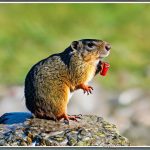Your cart is currently empty!

Ultimate Guide Series: How to Hunt Groundhogs

Table of Contents
Introduction
Hey there fellow hunters! If you’ve clicked your way to this article, there’s a good chance you’ve got groundhogs on your radar. Now, I’ve been hunting small game for the better part of two decades, and let me tell you, hunting these critters is quite the thrilling experience. Understanding how to hunt groundhogs is more than just aiming and shooting. It’s about recognizing their patterns, respecting their role in the ecosystem, and adapting to their surprisingly wily ways. Some see them as pesky garden raiders, others as challenging targets, but regardless of your viewpoint, there’s a fascinating world to discover when you dive into the art of groundhog hunting. Stick with me, and by the end of this guide, you’ll have a wealth of knowledge that’ll turn those groundhog hunting sessions into cherished memories. Ready to embark on this adventure?
Groundhog Basics: Know Your Prey
Understanding the creature you’re hunting is key to any successful expedition, and groundhogs are no exception. When it comes to these furry diggers, there’s more than meets the eye.
Groundhog Biology and Behavior
Often known by their other moniker, woodchucks, groundhogs are a part of the marmot family and can be identified by their stocky bodies and strong, sharp claws designed for digging. These little engineers primarily dwell in burrows, which can span from 8 to 66 feet! These burrows provide them protection against predators and serve as a place to hibernate during colder months. They’ve got an internal clock that’s uncanny. You can often find them basking in the sun during the earlier hours of the day, and by midday, they’ve usually retreated to the shade or their burrows. Their diet? Mainly greens. From clover, alfalfa, dandelions, to even some crops like carrots and beans.
Now, when it comes to behavior, groundhogs are surprisingly territorial. If you spot one standing on its hind legs, it’s probably on the lookout for threats or surveying its territory. This is something you’ll want to be mindful of when hunting. Their keen sense of sight and hearing makes sneaking up on them a challenge, but it’s part of what makes the hunt thrilling.
The Role of Groundhogs in the Ecosystem and the Importance of Ethical Hunting
Groundhogs play a pivotal role in our ecosystem. Their digging habits, while sometimes seen as a nuisance (especially if you’re a gardener dealing with their burrowing antics), contribute to soil aeration. This actually promotes healthier soil by allowing water and nutrients to penetrate more deeply. Additionally, their burrows can provide homes for other wildlife, like foxes, skunks, and even rabbits once abandoned.

So, with this understanding, it becomes crucial to approach groundhog hunting with respect and ethics. Overhunting can disrupt the balance in local ecosystems and create an imbalance that affects other wildlife too. It’s not just about the thrill of the chase; it’s about appreciating and respecting the balance of nature. When you’re out in the field, always be mindful of quotas and local regulations. Remember, we hunters play a stewardship role in the great outdoors. Let’s make sure we leave a legacy of responsibility and respect for the generations of hunters to come.
Essential Gear for Groundhog Hunting
Diving into groundhog hunting without the right gear is akin to going fishing without a rod. You might enjoy the scenery, but you’ll likely leave empty-handed. As an experienced small game hunter, I’ve had my share of hits and misses with equipment, and I’m here to steer you right. Let’s differentiate the must-haves from the nice-to-haves and guide you towards making your next groundhog hunting trip a success.
Essential vs. Optional Gear
In the grand outdoors, it’s always tempting to pack everything but the kitchen sink. However, when it comes to hunting groundhogs, it’s better to be streamlined.
Essential Gear:
- Firearm: A reliable, accurate rifle is your primary tool. More on this shortly.
- Optics: Quality scopes or binoculars to spot your prey from a distance.
- Camouflage: Depending on your location, choose attire that blends seamlessly with the surroundings.
- Ammo: Appropriate caliber rounds that offer precision without excessive damage.
- Sturdy Footwear: Groundhog terrains can be unpredictable. Solid boots can make all the difference.
Optional Gear:
- Range Finder: Helpful for calculating distances, especially for long shots.
- Groundhog Call: Mimics the sound of groundhogs, useful for drawing them out but not always necessary.
- Shooting Rest or Bipod: Stabilizes your shot but can be cumbersome for some.
Firearms, Optics, and Camouflage Recommendations
Firearms:
For groundhogs, precision is the name of the game. Bolt-action rifles in .223 or .22-250 calibers are popular choices. They offer accuracy, and the ammo is readily available. Another recommendation for those looking to get up close and personal is a .22 LR, but remember, this requires more stalking and a closer approach.

Optics:
Scopes with adjustable magnification between 3x and 9x are ideal for variable distances. If you’re just starting, don’t break the bank. Many decent scopes come at affordable prices. For those willing to invest a bit more, look for optics with clarity and a solid light transmission for those early morning or late afternoon hunts.
Camouflage:
Groundhogs have keen eyesight. To avoid being spotted, match your attire with the terrain. In grassy or agricultural fields, go for green and brown patterns. For rocky or barren terrain, lean towards grays and tans. It’s not just about the clothes; consider face paint or a mask to conceal reflective skin and movement.
In the world of groundhog hunting, preparation can mean the difference between a rewarding day and going home empty-handed. With the right gear in tow, not only will your chances of success soar, but you’ll also enjoy the thrill of the hunt even more.
Scouting and Locating Prime Groundhog Territory
Ah, the thrill of the chase! Hunting groundhogs isn’t just about taking that perfect shot; it’s about the entire process leading up to it. And let me tell you, identifying and understanding your hunting territory is paramount. Knowing where these critters hang out and their patterns is half the battle. So, let’s dive into the signs of groundhog activity and some cool scouting techniques that’ll make you feel like Sherlock in camo!
Recognizing Signs of Groundhog Activity
Groundhogs leave behind a few tell-tale signs of their presence. Here’s what to keep your eyes peeled for:
- Burrows: These are the most obvious signs. Look for large holes surrounded by mounds of freshly dug dirt. A groundhog’s main entrance will typically be around a foot in diameter.
- Tracks: Their footprints can be distinctive, with five toes on their front feet and four on their back. Groundhogs have a bit of a waddle, so their tracks might be closer together than you’d think.
- Eaten Vegetation: If you spot an area where vegetation looks like it’s been gnawed down to stubs, chances are, a groundhog had a feast there.
- Droppings: Groundhog droppings are pellet-like, similar to other rodents but slightly larger. These can often be found near their feeding spots.
Techniques for Scouting: Old School Meets New School
Traditional Methods:
- Observation Points: Find a high vantage point, like a hill or tree stand. Spend time watching during early morning or late afternoon when groundhogs are most active. Patience is your ally here.
- Walking the Terrain: Sometimes, there’s no substitute for putting boots on the ground. Walk the area, keeping an eye out for the signs mentioned above.
Tech-based Approaches:
- Trail Cameras: These are a game-changer. Set them up near suspected groundhog activity zones. They can capture images or videos when they detect movement, giving you insights into groundhog patterns and the best times to hunt.
- Drone Scouting: Got a drone? They can provide an aerial view of the territory, helping you spot potential burrows or feeding areas. Plus, let’s be honest, they’re pretty fun to fly.
- Apps and Maps: There are several hunting apps and maps available that allow users to mark and share activity spots. While they might not replace firsthand scouting, they can be a great starting point.
There you have it, folks. Scouting is about blending patience with a touch of detective work. Whether you’re a fan of the traditional approach or keen to embrace technology, understanding the territory is the foundation of any successful groundhog hunt. Remember, every minute spent scouting increases your chances of a memorable hunt. So, get out there, and may the groundhog clues be ever in your favor!
Best Times and Seasons for Groundhog Hunting
Like any seasoned hunter will tell you, timing is everything. You could have the sharpest aim, the best gear, and all the know-how, but if you’re not in the right place at the right time, that groundhog will remain a phantom. Let’s delve into the daily and seasonal patterns of groundhogs so you can ensure your next hunt is perfectly timed.
Analyzing the Groundhog’s Daily and Seasonal Patterns
Groundhogs, also known as woodchucks, are creatures of habit. Their daily and seasonal routines are quite predictable once you get the hang of them.
Daily Patterns:
Groundhogs are primarily diurnal, which means they’re most active during the day. Sunrise and sunset are their prime times. Early mornings see them venture out to feed, and late afternoons are reserved for a last munch before they retire for the night. During midday, especially in the heat of summer, they’re likely resting in their burrows. This siesta time is your cue to rest up for the evening hunt!
Seasonal Patterns:
Groundhogs hibernate, so winter is out of the question for hunting. They typically emerge from hibernation in early spring, around late March to early April, depending on the region. This emergence heralds the beginning of the groundhog hunting season. Spring is an ideal time as they’re actively looking for food and mates. By the time summer rolls in, they’re still active, but with the heat, their routines might be a tad irregular. Fall sees them preparing for hibernation again, which means they’re out and about, gathering food to store those fats for winter. This makes late summer to early fall another prime hunting period.
When to Go Out for Maximum Chances of a Successful Hunt
- Early Bird Gets the Groundhog: Sunrise is a golden hour. Get to your chosen spot early, set up, and wait. Groundhogs, after a night’s rest, are eager to get their first meal of the day.
- Dusk Delights: Just as the sun is setting, groundhogs are on the move again. This is your second-best window of opportunity.
- Spring Fling: As mentioned, spring is a busy time for groundhogs. They’re out of hibernation and hungry. Capitalize on this.
- Fall Forays: Late summer to early fall is prep time for winter. Groundhogs are keen on fattening up, which means more feeding and more chances for you.
Tactics and Techniques: From Stalk to Shoot
The chase, the anticipation, and the final moment of truth; hunting is as much about strategy as it is about skill. And when it comes to groundhogs, there’s a finesse to the game. These critters might look docile, but they’re wily, alert, and surprisingly agile. Let’s get down to the nuts and bolts of honing your groundhog hunting techniques, from the moment you spot one to the time you pull the trigger.
Approaches for Different Terrains and Environments
Open Fields and Pastures:
Groundhogs love the open spaces, where they can graze and keep an eye out for predators. Here, your best bet is to spot from a distance, perhaps using a high vantage point. Once you’ve located your target, approach slowly and steadily, using any natural cover available.

Wooded Areas:
These can be trickier. Groundhogs in wooded terrains are often more cautious, as the tree cover can hide predators. Use the trees to your advantage, moving quietly and listening for the characteristic sounds of groundhog activity.
Hilly or Rocky Terrain:
Groundhogs are known to favor slopes or elevated spots for their burrows, giving them a panoramic view of potential threats. Here, a circling approach works best. Try to come at them from an angle they’re not expecting, ideally with the sun behind you.
Shooting Techniques Specific to Groundhog Hunting
Factor in Distance:
Groundhogs are small targets, and a clean, ethical shot is essential. For shots within 100 yards, a steady hand and a good scope will serve you well. Beyond that, consider factors like wind direction and bullet drop. A rangefinder can be invaluable in these situations.
Reading Groundhog Behavior:
A groundhog standing tall is alert and scanning its surroundings. It might bolt if it senses danger. A groundhog focused on feeding is a more relaxed target but can be trickier to spot due to its lowered position.
Steady Your Shot:
When it’s time to shoot, especially from a distance, stability is key. If you don’t have a natural rest, consider using a bipod or shooting sticks. Breath control is vital; exhale slowly, squeeze the trigger gently, and avoid jerking.
Practice Makes Perfect:
Groundhogs are small, and their vital zones are even smaller. Regular target practice, ideally with targets the size of a groundhog’s vital zone, will enhance your accuracy.
Field Dressing and Uses for Groundhog
Alright, so you’ve had a successful hunt and now you’re holding a groundhog in your hands. What’s next? While the hunt is a thrill, the respect you show your game afterwards truly sets apart the novice from the experienced hunter. It’s time to discuss the art of field dressing and, yes, the culinary adventures that await with groundhog on the menu.
Proper Methods to Field Dress a Groundhog
Preparation: First and foremost, make sure you have sharp knives. A small game knife or a sharp pocket knife should do. You’ll also want rubber gloves – cleanliness is paramount.
- Position and Initial Cut: Lay the groundhog on its back. Starting just above the genitals, make an incision up the middle of the belly to the base of the rib cage. Be careful not to cut too deep; you don’t want to puncture the intestines.
- Remove Entrails: Gently use your fingers or the knife to separate the organs from the body wall. Pull the entrails out and set them aside.
- Cut and Remove: Next, you’ll want to cut around the anus and genital area, freeing the lower intestines. Once that’s done, pull the entire system out from the top.
- Clean the Cavity: With the entrails removed, ensure the body cavity is cleaned thoroughly. Rinse with cold water if available.
- Cool Quickly: If you’re not cooking your groundhog immediately, it’s crucial to cool the meat down as quickly as possible to prevent spoilage. Consider carrying a cooler with ice packs during your hunting trips.
Culinary Uses: Turning Your Game into a Meal
Groundhog, believe it or not, has a rich tradition in some American cuisines, particularly in the Appalachian regions. When prepared correctly, it can be quite the delicacy.
- Groundhog Stew: A classic method. Simply cube the meat, brown it, and then slow-cook it with veggies like potatoes, carrots, and onions. Season to taste. The slow cooking ensures the meat is tender and flavorful.
- Roasted Groundhog: Season your groundhog, perhaps with some rosemary, thyme, salt, and pepper. Roast it until the meat is tender. Serve with a side of roasted vegetables or a fresh salad.
- Groundhog Sausages: If you’re feeling adventurous, grind the meat, mix it with some pork fat (for juiciness), and seasonings. Then, stuff it into sausage casings. These can be grilled, fried, or used in various dishes.
Remember, like with any wild game, the taste of groundhog will vary based on its diet and habitat. Some might find it a bit gamey, while others relish its unique flavor. Regardless, there’s a sense of satisfaction in turning your hunt into a home-cooked meal. It’s the cycle of nature, and you’re a part of it. Bon appétit!
Ethical Considerations and Conservation
Hunting is not merely about the thrill of the chase or the satisfaction of a successful outing. It’s a responsibility, a tradition, and, when done right, a conservation tool. Delving into the nuances of ethical hunting and its broader implications for our ecosystems, we find that every choice we make in the field has far-reaching effects.
The Importance of Hunting Quotas and Respecting Local Laws
Every region has its own rhythm, and the wildlife populations therein can fluctuate based on numerous factors. To ensure that these populations remain healthy and sustainable, local authorities set hunting quotas.
- Responsible Regulation: Hunting quotas aren’t arbitrary. They’re based on research and population assessments. Adhering to these ensures the future availability of game and prevents undue strain on the species.
- Legal Repercussions: Beyond the ecological consequences, flouting hunting limits can lead to significant legal penalties, including fines and the suspension of hunting licenses. Always remain informed and updated on local regulations.
The Role of Hunters in Conservation and Maintaining Balanced Ecosystems
Active Participants: By being a hunter, you’re inherently involved in the world of conservation. Your license fees, for instance, often fund wildlife research, habitat restoration, and other essential conservation efforts.

Balancing Acts: Overpopulation of any species, even seemingly benign ones like groundhogs, can stress an ecosystem. Overgrazing can lead to soil erosion and impact other species. Responsible hunting helps maintain a balance, ensuring that one species doesn’t negatively impact the others in its habitat.
The Significance of Ethical Hunting Practices to Ensure Minimal Suffering
No animal should suffer unnecessarily. As hunters, this principle must be etched into our ethos.
- Aim True: Practice regularly to ensure you can make clean, humane shots that result in quick kills. This not only reduces suffering but also ensures the meat remains in the best possible condition.
- Know When Not to Shoot: Sometimes, the ethical choice is to hold fire. If you’re unsure of making a clean shot due to distance or the animal’s positioning, it’s better to wait for a clearer opportunity.
- Follow Up: If you shoot and the animal doesn’t drop immediately, it’s your responsibility to track and ensure it’s dispatched quickly.
- Respect the Animal: Every animal you hunt deserves respect. This means utilizing as much of it as possible and ensuring it wasn’t killed in vain.
Hunting, when approached with respect, knowledge, and ethics, becomes more than a sport or pastime. It’s a way of engaging with the world around us, of understanding the delicate balances in nature, and playing our part in maintaining them. Always remember: an ethical hunter is the true custodian of nature.
Related Questions
Can groundhogs be hunted year-round?
Well, while groundhogs are often active during the warmer months, they aren’t always out and about year-round. These little critters hibernate, usually from late fall to early spring. So, while technically you might find some spots allowing year-round hunting, your actual chances of spotting one during the colder months are slim to none. Best to focus your efforts during the late spring and summer when they’re most active.
What’s the difference between groundhogs and other similar animals like prairie dogs?
Ah, a common mix-up! Groundhogs and prairie dogs might seem similar, but they’re distinct critters. Groundhogs, also known as woodchucks, are larger and have a stouter build. They’re mostly solitary and dig deep burrows. Prairie dogs, on the other hand, are social creatures living in large colonies with a complex system of tunnels. And while both are rodents, their behaviors and habitats differ quite a bit.
Are there any specific laws and regulations about groundhog hunting?
Absolutely. Like all hunting, groundhog hunting is subject to local laws and regulations. Some places might require specific permits, while others could have designated seasons or quota limits. Always, and I mean always, check with your local Department of Wildlife or equivalent agency before heading out. It not only ensures you’re hunting legally but also ethically, keeping those groundhog populations healthy for future seasons.
Summary
Well, there you have it – our deep dive into the world of groundhog hunting. Whether you’re a seasoned hunter looking to add another feather (or should I say, fur?) to your cap, or a newbie curious about how to hunt groundhogs, I hope this guide shed some light on the nuances of the sport. Remember, hunting is as much about understanding and respecting the animal as it is about the thrill of the chase. Every outing is a chance to learn, adapt, and grow. Groundhog hunting is no different. It’s a blend of patience, strategy, and respect for the great outdoors. So, gear up, stay safe, and may your hunting sessions be filled with success and stories to share by the campfire. Happy hunting, folks!

Herb has been a longtime lover of the outdoors. Whether it be hunting, camping, fishing or just getting outside to reset. Proud father and animal lover. Bourbon anyone?

by
Tags:
Comments
4 responses to “Ultimate Guide Series: How to Hunt Groundhogs”
-
[…] always rushing, there’s something profoundly rewarding about the slow, deliberate pace of groundhog hunting. It’s not just about the hunt but the journey—those long moments of anticipation, the thrill of […]
-
[…] provides valuable tips and techniques for a successful groundhog hunt. Check out the article here to enhance your hunting skills and expand your hunting […]
-
[…] If you’re interested in Roosevelt elk hunting, you might also enjoy reading our article on “How to Hunt Groundhogs.” Groundhog hunting can be an exciting and challenging pursuit, and this article provides valuable tips and techniques for a successful hunt. Whether you’re a seasoned hunter or just starting out, this guide will help you improve your skills and increase your chances of bagging a groundhog. Check it out here! […]
-
[…] If you’re interested in hunting and want to learn more about different techniques and strategies, check out this article on “How to Hunt Groundhogs” from Old Oak Syndicate. Groundhog hunting can be a thrilling and challenging experience, and this article provides valuable tips and insights on how to effectively hunt these elusive creatures. Whether you’re a seasoned hunter or just starting out, this article is a must-read for anyone looking to improve their hunting skills. So grab your gear and head out into the field armed with the knowledge you need to successfully hunt groundhogs. Read more […]

Categories
- Big Game Hunting (301)
- Deer (202)
- Reviews (3)
- Shooting (16)
- Slingshot (1)
- Small Game Hunting (42)
- Upland Hunting (126)
- Waterfowl Hunting (3)





Leave a Reply